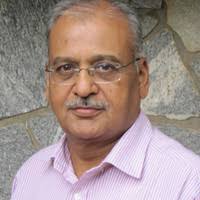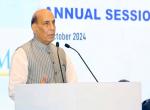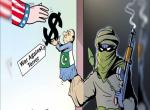India’s internal security mechanism, since Independence, has functioned in a silo system largely confined to the home ministry. It is obvious that this arrangement has outlived its utility and needs a massive make-over. Time has also become appropriate to make political administration of the internal security mechanism effective and result oriented. One way to achieving this objective is to create a set of principles that will ultimately constitute a national security doctrine or policy.
This policy should not be seen in a narrow military sense but expanded to include other organs of the government that also deal with the mechanics of national security. The connotation of national security must change making it incumbent of each citizen to consider it as his national duty. Contemporary developments underline the need to include central government departments and ministries, state owned enterprises, think-tanks and academic institutions, state governments and the private sector as stakeholders in the overall national security architecture.
A road map is contained in the report of the Kargil Review Committee (KRC), which devoted particular attention to India’s internal security challenges and responses. The KRC is the only comprehensive study undertaken on national security at the highest political levels in the country. Chapter-IV entitled “Internal Security” in the report of Group of Ministers Report on National Security is very relevant in present day context. The report of the Naresh Chandra Task Force which was constituted in 2011 on the reform of the intelligence apparatus adds new dimensions to the subject.
Management of internal security in today’s environment is primarily recognised as being a police function. The police are usually the first responder to civil developments. The central government maintains a large body of central armed police forces and several police organizations for this purpose to provide the safety net and provide assistance at all times. In addition the central government incurs massive expenditure on several police modernisation schemes and also provides special assistance to state governments.
Despite this, threats to national security have remained undiminished and new ones are emerging at regular intervals. There is no doubt that the security forces and agencies have developed appreciable degree of proficiency and success in dealing with internal security threats over the past several decades. However, no systematic efforts have been made to exploit these success stories to remove the root cause of the problems or issues that cast shadow on internal security. One of the fundamental reasons for this situation is attributed to the absence of strong political leadership to tackle reasons of instability. This factor also is responsible for absence of a road map or a strategy. It would appear that while dealing with internal threats, ruling parties have often times relegated national interests in favour of their narrow political agenda.
The police modernization program funded by the union government since the late 1960s till date has rendered yeoman service to the cause of national security and safety. Central assistance to the state governments has also kept pace despite existing limitations. These limitations are perhaps arising out of Constitutional provisions governing various aspects of centre-state relations on law and order related issues. The other factor is also attributed to the “coalition dharma” that prevailed at the centre for well over 30 years till May 2014, when the government of Prime Minister Modi took office. Failure to establish the National Counter Terrorism Centre (NCTC) is a prime example of this dilemma. There are other instances, as well. Evidently, there is now a pressing need to energise bi-partisan approach to such issues.
The time is opportune for the incumbent government to come up with new initiatives to make the modernization program more purposeful. It will be seen that the BJP led central government is yet to publicly announce contours of a national policy on pressing security related issues despite being in office for over fifteen months. It must address staffing arrangements so as to make the home ministry more broad-based and proactive in meeting its several responsibilities. Training of civil servants in national security is an important aspect. The need to induct laterally into its ranks best brains from other ministries, departments and “open” market such as Information Technology, Information and Communication Technology, Cyber experts to deal with state and non-state actors must be emphasized. Dependence on traditional staffing patterns must be done away as soon as possible. Several police officers and especially those from the central armed police forces opine that the officer-cadres must be strengthened with “even” more senior posts made available to them in both command and staff positions.
Adoption of best technology platforms by central armed police forces in prosecution of their duties is important. There is a very large reservoir of trained technical manpower available in the country. Among these are qualified young men and women pilots who are awaiting flying opportunities. The slump in aviation sector has created avenues for them to become eligible to join the air wing of the Border Security Force (BSF) both for flying and other ground duties. The sister forces of the BSF who may be considering their own air wing could benefit from open market recruitment.
Modernization must become a precursor to making our forces lean and mean and to bring in technology to act as a force multiplier. The recent advice of Shri Ajit Doval, National Security Advisor to the BSF on harnessing technology in its operational work is timely and worthy of quick implementation. A stage has arrived for our security forces to consider the use of Unmanned Aerial Vehicles (UAV’s) for surveillance roles. There are several applications for this platform especially for BSF, ITPB, SSB, CRPF, CISF and NDRF units. Ideally, each unit should be equipped with UAVs to act as “eyes and ears” in border guard duties, counter-insurgency operations, rescue and relief operations, crowd control and surveillance duties. This technology is available locally and can meet the requirements of our central forces leading to creation of force-multipliers and also give fillip to the fledgling local UAV industry. The experience of central forces in use of UAV technology can be shared with state governments. Technical personnel are available in the open market and if need be the services of short service commissioned officers of army, navy and air-force could be utilised to set-up the infrastructure including training, specialisation, analysis, repair and maintenance. Attractive pay and promotion packages for those joining the UAV stream or general pilot duties must be ensured. The induction of UAVs into central armed police forces must become an urgent item in modernisation programme of the central government and in doing so receive benefits from its “Make in India” policy. A definite timeline for this induction should be made with adequate financial commitments under various modernizations schemes.
Strengthening of the “special units” of the central armed police forces must receive more attention of the home ministry. This involves a cross-synergy between the home ministry and the defence ministry. It has been discussed in public domain for considerable period of time with very little results. The need to augment capacity to deal with asymmetrical warfare cannot be over-emphasised and in this direction sharing of expertise and experience becomes inevitable. Lateral induction of short service officers, with special-forces background, into CRPF units deployed in counter-insurgency grid must be considered. The advantages are many and will add more teeth to those units involved in anti-insurgency operations.
Police modernization programme must focus on upgrading training both at central and state level. Shri NN Vohra, Governor, Jammu and Kashmir, in his address on “Management of National Security” at the United Services Institution, Delhi in August 2014 shared his concerns on the subject. The key point he made was that the arrangements in the states left much to be desired and considerable efforts were needed to close the gap in quality and response. Several former IPS officers have dwelt exclusively on this subject. Shri. V. Balachandran, former Special Secretary, Government of India has written several articles related to the Mumbai incident of November 2011. A colleague of his, Mr Prakash Singh has taken the legal route to bring in police reforms.
Two major subjects namely Intelligence and Training form the crux of modernization programmes. Experience indicates that technical intelligence has become the favoured tool in counter-insurgency operations. The failure to give Human Intelligence or HUMINT its primacy in the intelligence gathering process must be urgently addressed. There are several agencies in India depending on Technical Intelligence or TECHINT to fulfil their tasks. Techint has severe limitations and must be used with care and caution. There is no substitute for Humint and practitioners of intelligence acquisition activities must “go back to roots”. While the Research and Analysis Wing (R&AW) and the Intelligence Bureau (IB) are foremost practitioners of Humint, they have developed high degree of skills in this format. Techint too forms part of their activities. The NTRO has its role cut out in this direction.
It would be ideal to create a National Academy of Intelligence as a platform to train state and central agencies in intelligence statecraft and also to look at impending threats and challenges to national security. Both the R&AW and the IB may provide the platform for civil and military agencies to partake of their rich experience.
Under the modernization programs, states may be encouraged to establish their own format of Centre for Counter-Terrorism (CTC) to combat terrorism which includes 24x7 automated surveillance mechanism, quick response and post incident analysis etc. These centres should possess the ability to detect, deter and destroy actions of “non-state” entities or “asymmetrical warfare”. The CTC would need to be separate from the state intelligence department, criminal investigation department or the special branch. The coastal security arrangements must engage the attention of the home ministry. A former senior navy officer remarked that much more requires to be done to empower state governments in this direction. He recommends that each state government creates a separate organization within the police department to handle all aspects of coastal security (b) create a cadre of dedicated personnel drawn from former navy servicemen and directly recruited police constables (c) create an inventory of boats and other hardware including repair and maintenance facility and (d) induct advanced technology like UAV and specific coastal surveillance program. According to another Navy veteran, the east coast of India, especially West Bengal and Orissa, needs to tighten its vigil since several vulnerabilities are yet to be addressed.
There is reluctance in the government to allow private sector participation in not only in security related issues but also training matters. The private sector enterprises have developed attractive packages in several interest areas such as counter-insurgency and counter-terrorism, security of vulnerable areas and vulnerable points, communications and safe communications technology and personnel security. With massive requirements to meet Homeland security demands, the relevant authorities must increase the area of private participation in related activities. The corporate sector too requires the assistance of private agencies to protect their assets. The home ministry must strive to create conditions for such participation.
Police modernization must address the quality and effectiveness of the Civil Defence and Home Guards Organisation. Both are important elements in the national security scenario. The Home Guards Organization plays a variety of roles, both in war and peace. The terms and condition and remunerations must be made financially attractive for people to join and render service. The possibility of the corporate sector joining hands to give the Home Guards Organization must be considered especially for watch and ward duties. There is a proliferation of private security agencies and private detective agencies nation-wide, there is however very little supervision and audit of their activities. A bulk of these fall short of set or expected standards. This is an issue for urgent redressal.
Police modernization must become an integral part of national security policy and therefore a strategic tool in its implementation. The political dimension of police modernization must be to ensure that while the police force gets the best possible attention, there must be equal attention to others in the field especially private sector participation in its activities. The most important aspect here is to bring the state governments at the highest political level to the national security debate and management of internal security. Without this understanding between state and central government, the national security infrastructure will remain weak and ineffective. India certainly cannot afford this stalemate.
PM Heblikar is Managing Trustee, Institute of Contemporary Studies Bangalore (ICSB) and former Special Secretary, in the Research and Analysis Wing (RAW).
Published in Vivek: Issues & Options, May - June 2015 Image Source: http://timesofindia.indiatimes.com










Post new comment